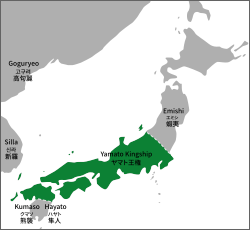
Back فترة أسوكا Arabic Перыяд Асука Byelorussian Асука Bulgarian আসুকা যুগ Bengali/Bangla Període Asuka Catalan Období Asuka Czech Asuka-Zeit German Asuka-epoko Esperanto Período Asuka Spanish Asuka Aroa Basque
Wakoku (until 701) Nippon (from 701) Wa (倭) to Nippon (日本) | |||||||||
|---|---|---|---|---|---|---|---|---|---|
| 538–710 | |||||||||
 Yamato Kingship in Japan | |||||||||
| Capital | Asuka (until 694) Fujiwara-kyō (694–710) | ||||||||
| Common languages | Old Japanese Middle Chinese | ||||||||
| Religion | Shinto Buddhism | ||||||||
| Government | Feudal monarchy | ||||||||
| Okimi (Emperor) | |||||||||
• 539/540–571 | Kinmei | ||||||||
• 707–710 | Genmei | ||||||||
| Ōomi (Soga Clan) | |||||||||
• 538/552–570 | Soga no Iname | ||||||||
• 626–645 | Soga no Emishi | ||||||||
| History | |||||||||
| 538 | |||||||||
| 607 | |||||||||
| 10 July 645 | |||||||||
| 645 | |||||||||
| 672 | |||||||||
• Asuka Kiyomihara Code proclaimed | 689 | ||||||||
• Taihō Code enacted | 701–718 | ||||||||
| 710 | |||||||||
| Currency | Fuhonsen | ||||||||
| |||||||||
| Part of a series on the |
| History of Japan |
|---|
 |
The Asuka period (飛鳥時代, Asuka jidai) was a period in the history of Japan lasting from 538 to 710, although its beginning could be said to overlap with the preceding Kofun period. The Yamato polity evolved greatly during the Asuka period, which is named after the Asuka region, about 25 km (16 mi) south of the modern city of Nara.
The Asuka period is characterized by its significant artistic, social, and political transformations, having their origins in the late Kofun period. The introduction of Buddhism marked a change in Japanese society. The Asuka period is also distinguished by the change in the name of the country from Wa (倭) to Nippon (日本).